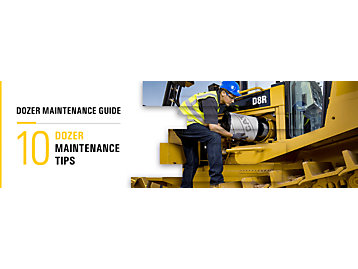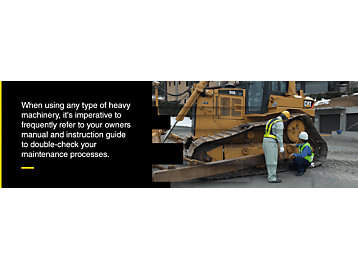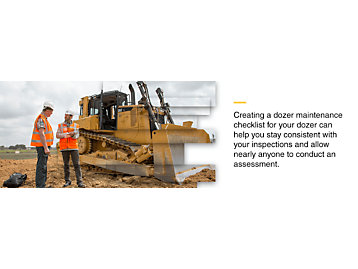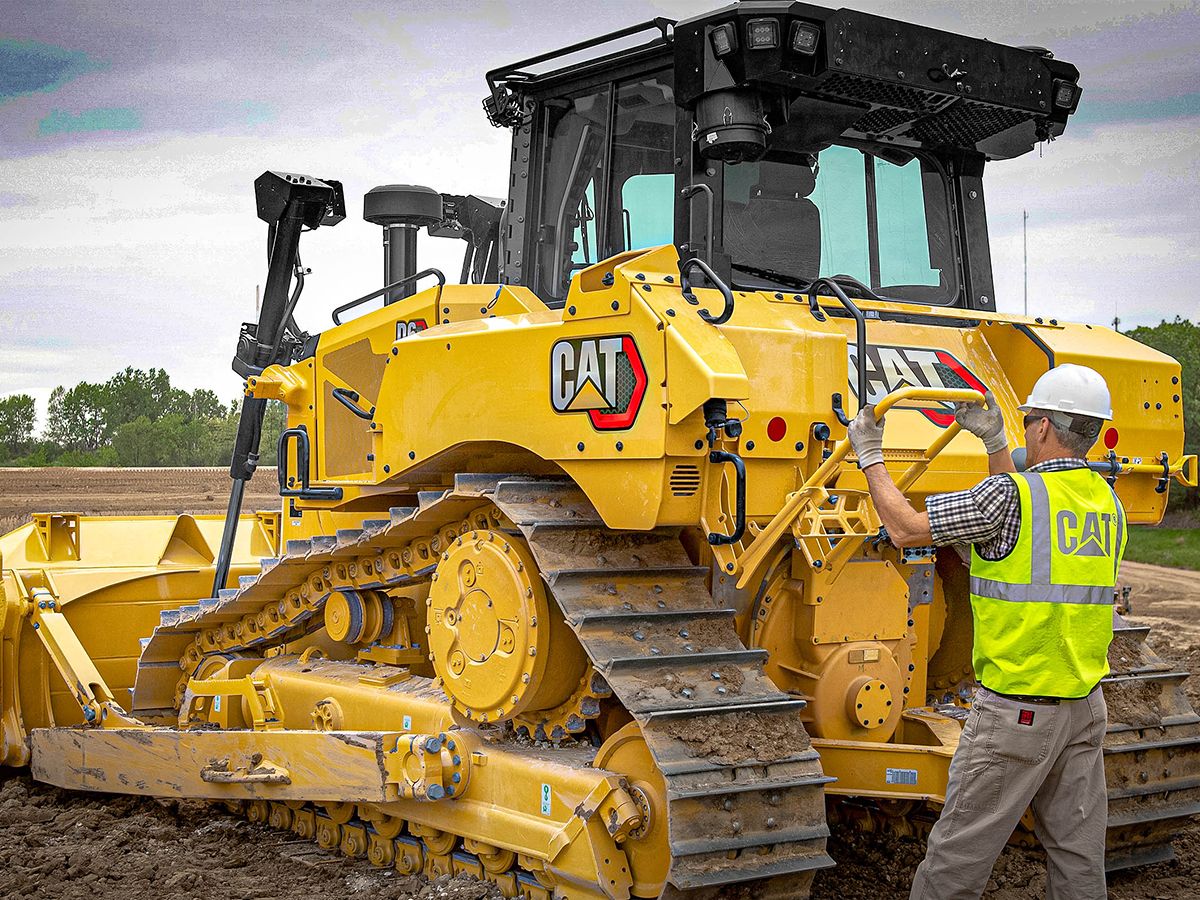

Sign In
Welcome! Sign In to personalize your Cat.com experience
If you already have an existing account with another Cat App, you can use the same account to sign in here
Register Now
One Account. All of Cat.
Your Caterpillar account is the single account you use to log in to select services and applications we offer. Shop for parts and machines online, manage your fleet, go mobile, and more.
Account Information
Site Settings
Security
Author: Small Business Expert | March 23, 2023 | Topic: Used Equipment

Bulldozers are one of the most fundamental pieces of heavy machinery equipment. Dozers are critical for moving earth, dirt, sand, debris, snow and many other types of materials with a large blade. These machines are perfect for a variety of construction jobs on rugged terrain, but it's important that you maintain and service them regularly so they will continue to work well.
If you have invested in a dozer for your business or construction needs, proper maintenance procedures are the most necessary components to ensure you're reducing wear and protecting your asset against leakage and damage. Use this Cat® dozer maintenance guide to stay on schedule with your servicing.
How to Maintain a Dozer
As with all heavy machinery, bulldozers require regular maintenance to perform well and keep up with extreme conditions. The most important part of maintaining your dozer is ensuring routine inspections to identify any leaks, wear or irregular issues before they become significant. When you catch these problems early, you will have plenty of time to schedule repairs ahead of an important project rather than dealing with a total machine failure on the day of the job.
While inspections are a top priority, there are other things you can do to maintain your dozer in between these checkups.
Clean Your Machine
You most likely use your dozer in all kinds of wet and dirty environments where the machine interacts with dust, sand, concrete, dirt and other debris. This material can build up over time and eventually cause mechanical issues.
Think about how important it is to wash your automobile every so often to prevent your investment from becoming worn down and dirty. You should remember the same practice for your dozer, as any accumulated grime and grease can deteriorate the condition of your equipment over time. Check the engine, cab, windows, mirrors and pivot points for dust and debris and wipe them clean regularly, especially after long hours of use.
Park Carefully
Parking your dozer properly is just as important as cleaning it. Parking your dozer on a hill or storing it outside for months at a time leaves it exposed to harsh weather conditions that cause wear and damage. Park your dozer on a level surface and keep it inside a warehouse if you're able to.
Check that you've engaged the dozer's parking brake and keep your transmission in neutral before performing any maintenance procedure when parking. Refer to your owner's manual to confirm the fluid levels are correct.
Change the Fuel Filter
It's important to keep up with your fuel filter because it catches impurities and contaminants and prevents them from entering and damaging your engine. If you're changing the fuel filter yourself, apply a lubricant for a good seal and keep your filter from touching any dirty or oily surfaces. Even if your filter has been recently changed, it's a good idea to inspect it regularly to detect any leakage.
Evaluate Cooling and Hydraulic Systems
A vital part of routine dozer maintenance is checking that your cooling and hydraulic systems are in good condition. For the cooling system, you must check that the coolant level meets the manufacturer's specifications. Be cautious when the engine is hot, and try not to open the radiator cap, as it can expel coolant from the system. Instead, check the oil and radiator cooler for debris that might be blocking air.
For the hydraulic system, check the hydraulic fluid reservoir and add fluid as needed to reach the required level. As with the cooling system, be careful to avoid contaminating the system with dirt or water.
10 Dozer Maintenance Tips
Many parts of a dozer can become damaged after long hours of heavy use on various job sites. Apart from regular maintenance, there are some elements to remember to help you keep your bulldozer in top shape and prevent unexpected malfunctions and breakdowns. Here are 10 tips for dozer maintenance:
1. Perform Regular Service
Performing regular checkups is one of the best dozer maintenance tips. Inspecting your machine every day may feel a bit tedious, but it's necessary to maintain optimal performance and condition for your dozer. Your dozer's servicing needs will depend on how often you use it, how well you maintain it and the conditions you keep it in.
For example, if you often neglect regular cleaning processes, fail to change the oil and other fluids at regular intervals, ignore built-up rust or constantly keep your dozer in harsh or wet conditions, it may take longer to get it serviced.
This issue can put you behind schedule, which is why regular service is so important. In addition to extending the lifespan of your dozer, daily and frequent maintenance will also help with increased operational and engine safety when in use. Always uphold safe practices when inspecting or servicing your machine on your own, and contact your dealer if you're unsure how to proceed.
2. Prevent the Chains From Rusting
Every part of the dozer is integral to operational efficiency, including the bolts and chains. These components generate the smooth movement of your dozer's wheels when performing jobs that require moving debris or clearing land. It's critical that these parts remain free of rust, or it may become difficult for your dozer to move efficiently.
Check the bolts and chains for excessive damage at regular intervals. This can help you keep maintenance and service scheduling in mind so it doesn't interfere with your projects or take up too much time to get replacements from your dealer.
3. Inspect the Undercarriage
As with automobiles, neglecting dozer undercarriage maintenance for long periods can have consequences. The dozer's undercarriage has the most contact with the earth while moving heavy loads, so it will become dirty quickly. When you clean your dozer, inspect and clean the undercarriage because debris can accumulate over time and interfere with necessary components — leading to mechanical issues over time.
Some areas of the undercarriage you must check for built-up debris or signs of wear include:
- Idlers
- Links
- Carrier roller
- Roller flanges
- Bottom rollers
- Track alignment
- Trackpads
- Tension spring
- Sprocket teeth
While it's normal for the undercarriage to be dirty on the surface level, it shouldn't have excessive damage or dust.
4. Check Your Engine Oil
The dozer's oil is important for preventing rust accumulation and reducing friction between moving parts. You must check the engine oil daily to confirm that it's clean and free from debris contamination — otherwise, you'll need to flush it out or replace it.
Staying on top of these oil checks is important to ensure machine oil levels are always in the safe operating range. You also need to verify that you're using the right type of engine oil. If you're unsure about any of these factors, follow the specifications from the manufacturer.
5. Remember Grease Application
In addition to engine oil, your dozer also needs frequent grease application to assist all moving parts and prevent rust from interfering with its operation. The areas you need to grease depend on the size and type of dozer you have, but the primary areas usually include:
- Pins
- Hinges
- U-joints
- Bearings
- Linkages
Every area of your dozer that requires a grease application will need a different amount, depending on the size of the area. While some spots may only need two or three shots of grease, others may need 20. Always ensure you're using the right type of grease for your equipment. Once you're done greasing all the necessary components, wipe and clean any excess grease before using your dozer.
6. Consult the Owners Manual
When using any type of heavy machinery, it's imperative to frequently refer to your owners manual and instruction guide to double-check your maintenance processes. You can also determine your dozer's maintenance schedule according to the manual, which will provide details about regular servicing needs and how to solve common problems.

7. Clean the Track Frame
Your dozer's track frame is likely in constant contact with muddy, dusty or frozen conditions, so cleaning it should be a part of your regular maintenance process. If working with wet or frozen materials, it's a good idea to clean the track frame while it's still warm from operation to prevent it from solidifying or crusting dirt and debris onto your dozer. You can use a track spade to clean out the gaps in the track frame to ensure smoother movement.
Dozer track maintenance will determine how well your machine will move throughout the job site. If you go too long without cleaning out the frozen or hard mud, it will become stuck on your track and make it extremely difficult for your dozer to move across the job site.
8. Uphold Good Habits
In addition to machine maintenance, one of the most important tips for maintaining dozers is upholding good habits with your dozer when in operation. Here are some best practices to follow:
- Use trained operators: If you allow other operators to use your dozer on a job site, ensure they are properly educated and trained in all safety practices. Otherwise, it puts their health and safety — and those of the other workers — at risk.
- Be cautious of speed: Though it's normal to want to get a job done quickly, constantly keeping your dozer at high speed can wear down the undercarriage faster and lead to significant deterioration from abrupt turns and reversing. Speed can affect the amount of wear on your dozer as equally as traveling long distances.
- Even out wear patterns: While some jobs require your dozer to work in one direction or motion, it can cause uneven wear on your tracks. Eventually, it will become hard to operate with tracks that have more wear on one side than the other, so make sure you operate in more than one direction to even them out.
- Make turns carefully: If you turn your dozer too quickly and abruptly, it can cause accelerated wear and stress on undercarriage components. Avoid sudden turns whenever possible to help maintain machine efficiency.
9. Monitor the Electrical System
The electrical system — consisting of wires and batteries — is a part of your dozer that you should never neglect. Always monitor the inner workings of your machine and ensure it's in good condition. Check for damaged or old batteries and see if you need to repair or replace anything. You should also confirm that your fuse system is working efficiently and your wiring is correct to avoid short circuits.
10. Keep Track of Air Filtration
Proper air filtration is necessary for your dozer to run efficiently. Check that your engine is free of dust and grime to reduce the chances of impurities or contaminants damaging your dozer. Be sure to inspect the housing, flexible lines, filter and steel components to keep track of their condition.
Daily Walkaround Dozer Inspection Checklist
Creating a dozer maintenance checklist for your dozer can help you stay consistent with your inspections and allow nearly anyone to conduct an assessment. The checklist will also remind you and your team to stay up-to-date with required maintenance and help you uphold safety standards.

Here's a general overview of what to look for in your daily dozer walkaround inspection:
- Walk around the machine and check for obvious problems like cracks, leaks, loose bolts and worn tracks.
- Look for warning tags on operating parts of the dozer.
- Check battery connections.
- Inspect the track tension and tightening if needed.
- Check fuel levels and fuel filters.
- Inspect the trackpads and trailing edges.
- Check air filters.
- Check the carrier roller and idler centering.
- Confirm there's a working fire extinguisher in the cabin.
- Inspect the windows, mirrors, flashing beacons and blinker lights.
- Clean the undercarriage as needed.
For a more detailed inspection, here's a compartmental breakdown of what to look for in each section of the dozer:
Outside of the Machine
In this area, you should be checking the outside of the dozer and the undercarriage for:
- Excessive wear
- Hardware damage
- Missing or loose bolts
- Debris buildup
- Oil leaks
- Improper adjustment
On the outside of the cab, you should also check the windows, fire extinguisher, windshield wipers, steps and handholds and other parts for:
- Condition and cleanliness
- Broken glass
- Date of inspection
- Oil level
- Debris, dirt and dust
- Damage or excessive wear
- Loose mounting bolts
Inside the Cab
On the inside of your dozer's cab, you should inspect the seat, horn, lights, backup alarm, indicators, switches, mirrors and cab air filter for:
- Proper adjustments
- Proper function
- Dirt and dust
- Correct operations
- Cleanliness
Engine Compartment
The engine compartment is the last step to your inspection. Conduct a thorough check of the engine oil and coolant, radiator, fuel filters and transmission oil and look for:
- Fluid levels
- Fin leaks and blockage
- Debris buildup
- Damaged fins and tubes
- Cracks and wear spots
Cat® Customer Value Agreements for Your Used Dozer
One of the best ways to ensure proper maintenance and smooth operation for your used dozer is to choose a Cat Customer Value Agreement (CVA). When you buy a Cat Used or Cat Certified Used machine, your CVA will provide you with the right parts — delivered on schedule as you need them.
Depending on your dealer and your choice of a Cat Used CVA or a Cat Certified CVA, you can track machine insights on your phone and receive flexible service options.
Here are the main benefits:
- Hassle-free: Delivered parts will keep you on track with your dozer maintenance schedule, and your machine ownership also includes advice and easy parts instructions. You may also be eligible to roll your CVA and machine into one monthly payment.
- Security: Optional troubleshooting, diagnostics and repairs with machine and component protection.
- Peace of mind: Your CVA will also grant you access to monitor your machine hours, location, health alerts and inspection results through the Cat App and website.
You will also benefit from other included and optional features like trained dealer labor and priority response services.
Find a Cat Dealer Near You
When it comes to heavy machinery, you have plenty of options for equipment, repairs and maintenance advice from your local Cat dealer. Buying used dozers is a great way to expand your options without expanding your budget. Whether you're looking to shop for used dozers for the first time or adding another used dozer to your collection, you can maximize your investment and choose optional maintenance features to support your needs.



